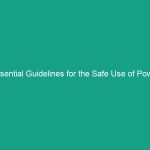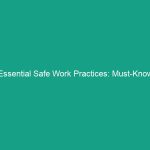Introduction
Health, Safety, and Environment (HSE) practices are crucial in ensuring that construction sites operate smoothly and safely, particularly when it comes to managing the risks posed by wind and weather conditions. Construction sites are inherently dangerous places, and adverse weather can exacerbate these dangers significantly. Proper Wind and Weather Safety for Construction Sites is not just a regulatory requirement but a vital aspect of protecting the well-being of workers and the integrity of the project.
Weather-related incidents can lead to severe injuries, project delays, and increased costs. Therefore, understanding how to prepare for and respond to various weather conditions is essential for everyone involved in construction. In this article, we will explore the regulatory frameworks, best practices, case studies, challenges, and future trends in Wind and Weather Safety for Construction Sites.
Regulatory Frameworks
The regulatory landscape surrounding wind and weather safety on construction sites is multifaceted and varies by region. In many countries, OSHA (Occupational Safety and Health Administration) sets forth guidelines that outline the responsibilities of employers to ensure a safe working environment. These guidelines often include specific provisions for addressing weather-related Hazards, emphasizing the need for risk assessments and contingency planning.
Understanding osha Regulations
OSHA regulations require employers to provide a workplace free from recognized Hazards that can cause death or serious physical harm. In terms of weather safety, this includes:
- Conducting regular weather assessments and forecasts.
- Training workers on recognizing weather-related hazards.
- Implementing Safety Measures for high wind conditions, such as securing scaffolding and equipment.
Employers must stay informed about the latest weather forecasts and be prepared to act quickly to protect workers during severe weather events, such as storms or high winds.
International Guidelines and Standards
Outside of the United States, various international standards also provide guidance on managing wind and weather safety. The International Organization for Standardization (ISO) has established standards that address risk management in construction projects, which include environmental considerations like wind speed and weather conditions. Adherence to these guidelines helps ensure that construction practices meet global safety standards.
Best Practices for Wind and Weather Safety
Implementing Best Practices for Wind and Weather Safety for Construction Sites is essential for minimizing risks. These practices are proactive measures that can significantly reduce the potential for accidents and injuries.
Conducting Thorough Risk Assessments
Before starting any project, a comprehensive risk assessment should be conducted to identify potential weather-related hazards. This assessment should include:
- Analysis of typical weather patterns in the project’s location.
- Identification of specific vulnerabilities of the construction site.
- Development of strategies to mitigate identified risks.
Regular updates to the risk assessment are vital, as weather conditions can change rapidly, and new risks may emerge throughout the project lifecycle.
Developing a Weather Response Plan
A well-defined weather response plan is critical for effective management of adverse weather conditions. This plan should include:
- Clear communication protocols for disseminating weather alerts to all workers.
- Emergency Procedures to follow in the event of severe weather.
- Designated safe zones for workers to relocate during dangerous conditions.
Regular drills and simulations can help ensure that all workers know their roles in the event of inclement weather, making the response more effective.
Training and Awareness Programs
Ongoing Training and awareness programs are essential for promoting a culture of safety regarding Wind and Weather Safety for Construction Sites. Workers should be educated about:
- Recognizing signs of approaching severe weather.
- Understanding the risks associated with specific weather conditions.
- Proper use of Personal Protective Equipment (PPE) during adverse weather.
By fostering a safety-first mindset, workers will be more vigilant and proactive in protecting themselves and their colleagues.
Case Studies: Learning from Real-World Incidents
Examining past incidents of weather-related accidents on construction sites can provide invaluable insights into the importance of Wind and Weather Safety for Construction Sites. These case studies highlight both the consequences of inadequate Safety Measures and the Benefits of effective planning.
Case Study 1: The Importance of Preparation
In 2017, a construction site in Texas experienced a severe thunderstorm that resulted in high winds and heavy rain. Workers had not been trained on the site’s weather response plan, which led to confusion and disorganization as conditions worsened. Several workers were injured when debris was blown from scaffolding due to high winds.
This incident underscores the need for comprehensive training and preparedness. Following the accident, the construction company developed a robust weather response plan and instituted mandatory training sessions that significantly improved worker safety during adverse weather.
Case Study 2: Effective Communication Saves Lives
Another notable incident occurred in Florida, where a construction team was caught off-guard by an unexpected storm. The project manager had been monitoring weather updates but failed to communicate the potential for severe weather to the crew. As a result, workers were still on-site when the storm hit, leading to several injuries from falling objects.
This case illustrates the critical importance of communication. The company implemented a new protocol requiring regular weather updates to be shared with all employees, which greatly enhanced safety in subsequent projects.
Challenges in Implementing Wind and Weather Safety
Despite the importance of Wind and Weather Safety for Construction Sites, several challenges persist in effectively implementing safety measures. Recognizing these challenges is the first step toward overcoming them.
Budget Constraints
Many construction companies operate on tight budgets, which can lead to underinvestment in safety training and equipment. Prioritizing weather safety often takes a back seat to cost-cutting measures. However, investing in safety not only protects workers but can also save money in the long run by preventing accidents and project delays.
Inconsistent Communication
Inconsistent communication between project managers and workers can lead to misunderstandings regarding safety protocols. Ensuring that all team members are on the same page about weather risks and responses is crucial. Implementing standardized communication practices can help mitigate this issue.
Resistance to Change
Some companies may face resistance from workers when introducing new safety protocols. Employees accustomed to certain practices may be hesitant to adopt new methods. Engaging workers in the development of safety practices and emphasizing the importance of their input can foster a more positive attitude toward change.
Future Trends in Wind and Weather Safety
The future of Wind and Weather Safety for Construction Sites is likely to be shaped by advancements in technology and a growing emphasis on Sustainability. As the construction industry continues to evolve, so too will the strategies employed to ensure worker safety in adverse weather conditions.
Technology Integration
The integration of technology, such as drones and weather-monitoring systems, is becoming increasingly important in construction safety. Drones can provide real-time data on weather conditions and site safety, while advanced weather forecasting tools can alert teams to potential hazards before they occur.
Emphasis on Sustainability
As the construction industry shifts toward sustainable practices, the consideration of climate change and extreme weather events becomes paramount. Future projects will likely involve designs and materials that can withstand severe weather, thus promoting both worker safety and environmental responsibility.
Conclusion
In conclusion, ensuring Wind and Weather Safety for Construction Sites is a multifaceted challenge that requires a proactive approach, robust training, and effective communication. By understanding the regulatory frameworks, implementing Best Practices, learning from case studies, addressing challenges, and embracing future trends, construction companies can significantly improve Workplace Safety.
As we move forward, it is imperative that all stakeholders in the construction industry prioritize health, safety, and environmental practices. Together, we can create safer working environments that protect workers and ensure the successful completion of projects. Take action today by reviewing your current safety practices and incorporating these essential tips into your operations!


